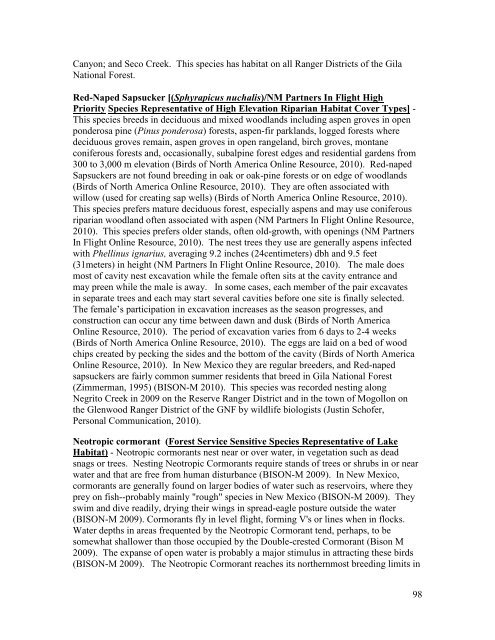Wildlife Specialist report
Wildlife Specialist report
Wildlife Specialist report
Create successful ePaper yourself
Turn your PDF publications into a flip-book with our unique Google optimized e-Paper software.
Canyon; and Seco Creek. This species has habitat on all Ranger Districts of the Gila<br />
National Forest.<br />
Red-Naped Sapsucker [(Sphyrapicus nuchalis)/NM Partners In Flight High<br />
Priority Species Representative of High Elevation Riparian Habitat Cover Types] -<br />
This species breeds in deciduous and mixed woodlands including aspen groves in open<br />
ponderosa pine (Pinus ponderosa) forests, aspen-fir parklands, logged forests where<br />
deciduous groves remain, aspen groves in open rangeland, birch groves, montane<br />
coniferous forests and, occasionally, subalpine forest edges and residential gardens from<br />
300 to 3,000 m elevation (Birds of North America Online Resource, 2010). Red-naped<br />
Sapsuckers are not found breeding in oak or oak-pine forests or on edge of woodlands<br />
(Birds of North America Online Resource, 2010). They are often associated with<br />
willow (used for creating sap wells) (Birds of North America Online Resource, 2010).<br />
This species prefers mature deciduous forest, especially aspens and may use coniferous<br />
riparian woodland often associated with aspen (NM Partners In Flight Online Resource,<br />
2010). This species prefers older stands, often old-growth, with openings (NM Partners<br />
In Flight Online Resource, 2010). The nest trees they use are generally aspens infected<br />
with Phellinus ignarius, averaging 9.2 inches (24centimeters) dbh and 9.5 feet<br />
(31meters) in height (NM Partners In Flight Online Resource, 2010). The male does<br />
most of cavity nest excavation while the female often sits at the cavity entrance and<br />
may preen while the male is away. In some cases, each member of the pair excavates<br />
in separate trees and each may start several cavities before one site is finally selected.<br />
The female’s participation in excavation increases as the season progresses, and<br />
construction can occur any time between dawn and dusk (Birds of North America<br />
Online Resource, 2010). The period of excavation varies from 6 days to 2-4 weeks<br />
(Birds of North America Online Resource, 2010). The eggs are laid on a bed of wood<br />
chips created by pecking the sides and the bottom of the cavity (Birds of North America<br />
Online Resource, 2010). In New Mexico they are regular breeders, and Red-naped<br />
sapsuckers are fairly common summer residents that breed in Gila National Forest<br />
(Zimmerman, 1995) (BISON-M 2010). This species was recorded nesting along<br />
Negrito Creek in 2009 on the Reserve Ranger District and in the town of Mogollon on<br />
the Glenwood Ranger District of the GNF by wildlife biologists (Justin Schofer,<br />
Personal Communication, 2010).<br />
Neotropic cormorant (Forest Service Sensitive Species Representative of Lake<br />
Habitat) - Neotropic cormorants nest near or over water, in vegetation such as dead<br />
snags or trees. Nesting Neotropic Cormorants require stands of trees or shrubs in or near<br />
water and that are free from human disturbance (BISON-M 2009). In New Mexico,<br />
cormorants are generally found on larger bodies of water such as reservoirs, where they<br />
prey on fish--probably mainly "rough" species in New Mexico (BISON-M 2009). They<br />
swim and dive readily, drying their wings in spread-eagle posture outside the water<br />
(BISON-M 2009). Cormorants fly in level flight, forming V's or lines when in flocks.<br />
Water depths in areas frequented by the Neotropic Cormorant tend, perhaps, to be<br />
somewhat shallower than those occupied by the Double-crested Cormorant (Bison M<br />
2009). The expanse of open water is probably a major stimulus in attracting these birds<br />
(BISON-M 2009). The Neotropic Cormorant reaches its northernmost breeding limits in<br />
98
















